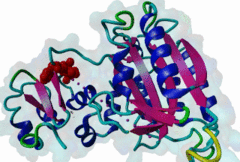LIG_BIR_III_2
| Accession: | |
|---|---|
| Functional site class: | IAP-binding motif (IBM) |
| Functional site description: | The IBM specifically binds to the conserved BIR (baculoviral IAP repeat) domain that is found in Inhibitor of Apoptosis Proteins (IAPs). The motif is located at the N-terminal regions of caspases and pro-apoptotic IAP-antagonising proteins. In non-apoptotic cells, caspase activity is suppressed by the binding of IAPs to activated caspases. Upon apoptotic stimuli, pro-apoptotic IAP-antagonising proteins compete with the caspases for binding to the IAP or mediate their proteolytic degradation which leads to apoptosis promotion. |
| ELMs with same func. site: | LIG_BIR_II_1 LIG_BIR_III_1 LIG_BIR_III_2 LIG_BIR_III_3 LIG_BIR_III_4 |
| ELM Description: | Type III BIR domains are characterised by conserved Glu/Gln and Trp residues in the IBM binding groove. They bind neo N-terminal motifs that are revealed after cleavage of pro-caspases into effector or initiator caspases. As caspases are commonly cleaved by other caspases or granzyme B, the motif is predominantly found C-terminal of aspartate residues. IBMs selective for type III BIR domains contain a conserved alanine residue in the first position followed by a variable position, a conserved proline in the third and another variable residue in the fourth position (DA.P.). In humans, the proline residue seems to be highly selective, as it enables a kink in the peptide chain, which is necessary for the accommodation of the P4 residue into its binding groove (Eckelman,2008). |
| Pattern: | DA.P. |
| Pattern Probability: | 0.0003511 |
| Present in taxon: | Metazoa |
| Interaction Domain: |
BIR (PF00653)
Inhibitor of Apoptosis domain
(Stochiometry: 1 : 1)
|
In multicellular organisms apoptosis has to be strictly regulated to maintain the equilibrium between cell proliferation and cell death. Dysregulation of apoptosis is linked to several diseases, especially cancer (Meier,2007). Inhibitor of Apoptosis Proteins (IAPs) are involved in apoptosis regulation but also exhibit several other functions in immunity, signal transduction via TNF-receptors, mitosis regulation etc. The first IAP was identified in the genome of Cydia pomonella granulosis virus, a baculovirus, where it blocks apoptotic mechanisms of the infected host cell to facilitate viral replication (Crook,1993). As a common structural element, IAPs possess one to three baculoviral IAP repeat domains (BIR domains, PF00653). These domains (built up by ~70 residues) are organised in 4 to 5 alpha-helices and a three-stranded zinc coordinated beta-sheet. To date there are eight known IAPs in humans: BIRC1 (NAIP), BIRC2 (c-IAP1), BIRC3 (c-IAP2), BIRC4 (XIAP), BIRC5 (survivin), BIRC6 (apollon), BIRC7 (ML-IAP), BIRC8 (ILP-2). BIRC 1-4 contain three BIR domains whereas in BIRC 5-8 only one BIR domain is found (Dubrez-Daloz,2008). According to conserved residues in their sequences the different kinds of BIR domains may be classified into type I, II and III domains. (Eckelman,2008). By direct suppression of initiator and effector caspases, apoptosis inhibition is mainly mediated by XIAP (BIRC4) (LaCasse,2008). Upon apoptotic stimuli, IAP-antagonising proteins such as SMAC (Second Mitochondria-derived Activator of Caspases) and HtrA2 liberate caspases from the inhibitory proteins by competitive binding, proteolytic degradation or ubiquitinylation and thereby promote apoptotic processes within the cell. As IAPs are often overexpressed in various human cancers and an elevated IAP expression is linked to poor prognosis, IAP inhibitors have been developed to target IAPs in cancer therapy. Peptides and small molecules based on the aminoterminal structure of SMAC have been shown to effectively promote apoptosis in human cancer cell lines as well as animal models (Zobel,2006; Vucic,2007). |
-
An apoptosis-inhibiting baculovirus gene with a zinc finger-like motif.
Crook NE, Clem RJ, Miller LK
J Virol 1993 Apr; 67 (4), 2168-74
PMID: 8445726
-
IAP proteins: blocking the road to death's door.
Salvesen GS, Duckett CS
Nat Rev Mol Cell Biol 2002 Jun; 3 (6), 401-10
PMID: 12042762
-
Mechanism of XIAP-mediated inhibition of caspase-9.
Shiozaki EN, Chai J, Rigotti DJ, Riedl SJ, Li P, Srinivasula SM, Alnemri ES, Fairman R, Shi Y
Mol Cell 2003 Feb; 11 (2), 519-27
PMID: 12620238
-
Design, synthesis, and biological activity of a potent Smac mimetic that
sensitizes cancer cells to apoptosis by antagonizing IAPs.
Zobel K, Wang L, Varfolomeev E, Franklin MC, Elliott LO, Wallweber HJ, Okawa DC, Flygare JA, Vucic D, Fairbrother WJ, Deshayes K
ACS Chem Biol 2006 Sep 19; 1 (8), 525-33
PMID: 17168540
-
The inhibitor of apoptosis proteins as therapeutic targets in cancer.
Vucic D, Fairbrother WJ
Clin Cancer Res 2007 Oct 15; 13 (20), 5995-6000
PMID: 17947460
-
Lucifer's labyrinth--ten years of path finding in cell death.
Meier P, Vousden KH
Mol Cell 2007 Dec 14; 28 (5), 746-54
PMID: 18082600
-
The mechanism of peptide-binding specificity of IAP BIR domains.
Eckelman BP, Drag M, Snipas SJ, Salvesen GS
Cell Death Differ 2008 May; 15 (5), 920-8
PMID: 18239672
-
IAPs: more than just inhibitors of apoptosis proteins.
Dubrez-Daloz L, Dupoux A, Cartier J
Cell Cycle 2008 Apr 15; 7 (8), 1036-46
PMID: 18414036
-
IAP-targeted therapies for cancer.
LaCasse EC, Mahoney DJ, Cheung HH, Plenchette S, Baird S, Korneluk RG
Oncogene 2008 Oct 20; 27 (48), 6252-75
PMID: 18931692
(click table headers for sorting; Notes column: =Number of Switches, =Number of Interactions)
| Acc., Gene-, Name | Start | End | Subsequence | Logic | #Ev. | Organism | Notes |
|---|---|---|---|---|---|---|---|
| P55210 CASP7 CASP7_HUMAN |
23 | 27 | SANEDSVDAKPDRSSFVPSL | TP | 1 | Homo sapiens (Human) | |
| Q7K4Z4 imd Q7K4Z4_DROME |
30 | 34 | VEGRLEKDAAPVDDNEPDNN | TP | 1 | Drosophila melanogaster (Fruit fly) | |
| P55211 CASP9 CASP9_HUMAN |
315 | 319 | PGSNPEPDATPFQEGLRTFD | TP | 4 | Homo sapiens (Human) |
Please cite:
ELM-the Eukaryotic Linear Motif resource-2024 update.
(PMID:37962385)
ELM data can be downloaded & distributed for non-commercial use according to the ELM Software License Agreement
ELM data can be downloaded & distributed for non-commercial use according to the ELM Software License Agreement

